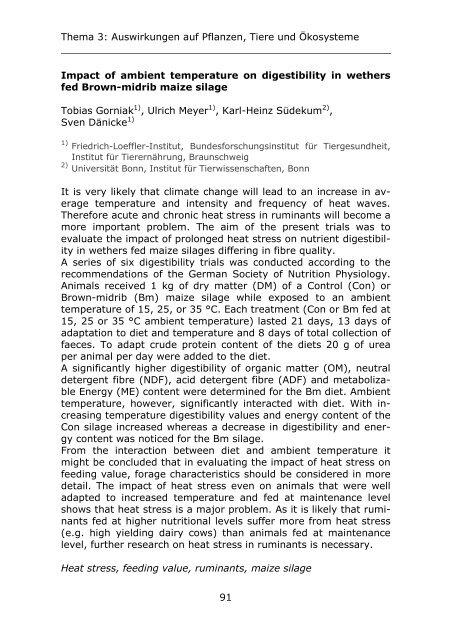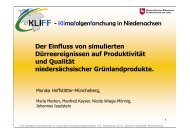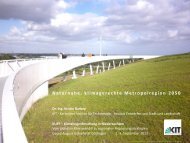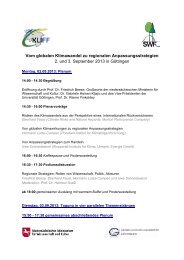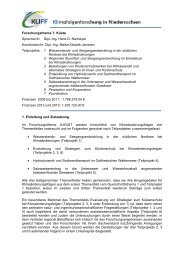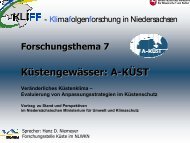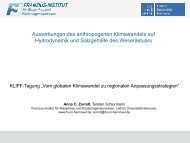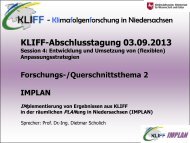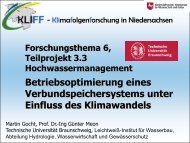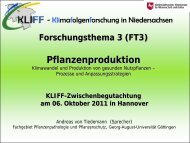Abstract-Band KLIFF-Tagung 2.und 3.9.13
Abstract-Band KLIFF-Tagung 2.und 3.9.13
Abstract-Band KLIFF-Tagung 2.und 3.9.13
Sie wollen auch ein ePaper? Erhöhen Sie die Reichweite Ihrer Titel.
YUMPU macht aus Druck-PDFs automatisch weboptimierte ePaper, die Google liebt.
Thema 3: Auswirkungen auf Pflanzen, Tiere und ÖkosystemeImpact of ambient temperature on digestibility in wethersfed Brown-midrib maize silageTobias Gorniak 1) , Ulrich Meyer 1) , Karl-Heinz Südekum 2) ,Sven Dänicke 1)1)Friedrich-Loeffler-Institut, Bundesforschungsinstitut für Tiergesundheit,Institut für Tierernährung, Braunschweig2)Universität Bonn, Institut für Tierwissenschaften, BonnIt is very likely that climate change will lead to an increase in averagetemperature and intensity and frequency of heat waves.Therefore acute and chronic heat stress in ruminants will become amore important problem. The aim of the present trials was toevaluate the impact of prolonged heat stress on nutrient digestibilityin wethers fed maize silages differing in fibre quality.A series of six digestibility trials was conducted according to therecommendations of the German Society of Nutrition Physiology.Animals received 1 kg of dry matter (DM) of a Control (Con) orBrown-midrib (Bm) maize silage while exposed to an ambienttemperature of 15, 25, or 35 °C. Each treatment (Con or Bm fed at15, 25 or 35 °C ambient temperature) lasted 21 days, 13 days ofadaptation to diet and temperature and 8 days of total collection offaeces. To adapt crude protein content of the diets 20 g of ureaper animal per day were added to the diet.A significantly higher digestibility of organic matter (OM), neutraldetergent fibre (NDF), acid detergent fibre (ADF) and metabolizableEnergy (ME) content were determined for the Bm diet. Ambienttemperature, however, significantly interacted with diet. With increasingtemperature digestibility values and energy content of theCon silage increased whereas a decrease in digestibility and energycontent was noticed for the Bm silage.From the interaction between diet and ambient temperature itmight be concluded that in evaluating the impact of heat stress onfeeding value, forage characteristics should be considered in moredetail. The impact of heat stress even on animals that were welladapted to increased temperature and fed at maintenance levelshows that heat stress is a major problem. As it is likely that ruminantsfed at higher nutritional levels suffer more from heat stress(e.g. high yielding dairy cows) than animals fed at maintenancelevel, further research on heat stress in ruminants is necessary.Heat stress, feeding value, ruminants, maize silage91


